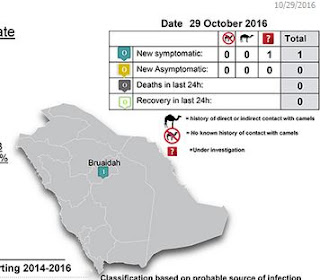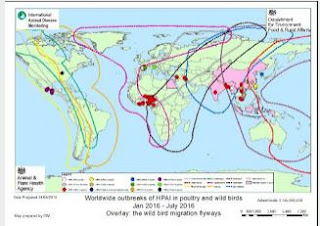#11,850
A little over a month ago, in
MMWR: Investigation Into the `Unique' Utah Zika Case, we looked at the CDC's investigation into the infection of a family member caring for a relative with Zika, without any of the known risk exposures (
mosquito vector, sexual contact, blood transfusion).
The elderly family member - who had serious comorbidities - died of
organ failure on June 25th, while the caregiver developed symptoms on
July 1st.
Of particular note, the MMWR reported that `
The index patient’s blood specimen obtained 2 days before his death had a level of viremia approximately 100,000 times higher than the average level reported in persons infected with Zika virus (2).'
Despite a detailed investigation, exactly how this caregiver contracted the Zika virus remains unclear, causing the CDC to warn: `
. . . family contacts should be aware that blood and body fluids of severely ill patients might be infectious.'
Hyperbolic tabloid headlines aside, the evidence suggests this to be a very rare occurrence with Zika.
Nevertheless, this scenario is assumed a possibility by all healthcare workers who adhere to the
`Standard Precautions' principle, but is less often considered by family members or lay people.
The CDC defines `Standard Precautions' as:
Standard Precautions represent the minimum infection prevention
measures that apply to all patient care, regardless of suspected or
confirmed infection status of the patient, in any setting where
healthcare is delivered. These evidence-based practices are designed to
both protect healthcare personnel and prevent the spread of infections
among patients.
Standard Precautions replaces earlier guidance relating
to Universal Precautions and Body Substance Isolation. Standard
Precautions include: 1) hand hygiene, 2) use of personal protective
equipment (e.g., gloves, gowns, facemasks), depending on the
anticipated exposure, 3) respiratory hygiene and cough etiquette, 4)
safe injection practices, and 5) safe handling of potentially
contaminated equipment or surfaces in the patient environment.
The CDC has published an updated
Healthcare Exposure To Zika and Infection Control document, which addresses both HCW, and lay caregivers and visitors, who may be exposed to a Zika patient.
The document has 8 main sections:
The gist being:
Preventing Exposure in Healthcare Settings
Standard Precautions should be used to protect healthcare personnel
from all infectious disease transmission, including Zika virus. Standard
Precautions are based on the fact that all blood, body fluids,
secretions, excretions, non-intact skin, and mucous membranes might
contain transmissible infectious agents. Body fluids, including blood,
vaginal secretions, and semen, have been implicated in transmission of
Zika virus. Current information about Zika virus transmission and risks
can be found on CDC’s Zika Transmission webpage.
HCWs will want to read the full document for specific scenarios, room disinfection procedures, and testing recommendations. For the general public, the CDC has the following advice:
Advising Caretakers and Visitors of People with Zika
As with any other infectious illness, family members and other caregivers should take the following precautions
- Do not touch blood or body fluids and surfaces contaminated with these fluids with exposed skin.
- Wash hands with soap and water immediately after providing care to
the patient. If hands are not visibly dirty, an alcohol-based hand rub
can be used instead of soap and water.
- Immediately remove and wash clothes if they get blood or body fluids
on them. Use laundry detergent and the water temperature specified in
the garment care instructions to wash clothes soiled with blood or body
fluids. Using bleach is not necessary.
- Immediately clean and disinfect surfaces that have blood or other
body fluids on them, minimizing direct contact, using household
detergent/disinfectant according to manufacturer’s instructions. The
sick person’s immediate environment should be cleaned daily using
household cleaners according to manufacturer’s instructions.
Pregnant women should follow the same precautions as other family
members caring for a person with Zika, including avoiding activities
that would expose them to blood or other potentially infectious body
fluids.
When visiting a patient in a hospital setting, visitors should not
engage in activities that could possibly expose them to blood or body
fluids from a hospitalized patient. Helping a patient with sitting up in
bed or walking should not expose someone to blood or body fluids;
however, family members and caregivers should pay attention to hygiene,
not touch blood or body fluids or surfaces soiled with them, and wash
hands before and after touching the patient.
Common sense precautions that should apply whenever you are providing care to another person, regardless of whether they have a Zika infection, Influenza, or the common cold.
And a pretty good reason to keep a modest supply of exam gloves, surgical masks, and hand sanitizer in your home (
and auto) first aid kit (see
#NatlPrep : One For The Home, And One More For The Road).



























 =
= 